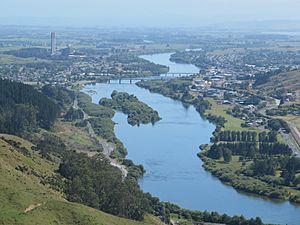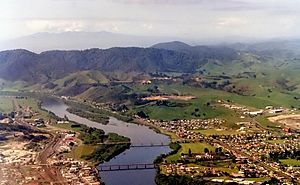Huntly, New Zealand facts for kids
Quick facts for kids
Huntly
Rahui-Pōkeka (Māori)
|
|
|---|---|
|
Minor urban area
|
|

Waikato River, Huntly and Huntly power station from Hakarimatas in 2012
|
|
| Country | New Zealand |
| Region | Waikato |
| Territorial authority | Waikato District |
| Elevation | 15 m (49 ft) |
| Population
(June 2023)
|
|
| • Total | 8,880 |
| Postcode(s) |
3700
|
Huntly (Māori: Rahui-Pōkeka) (population 8,880) is a town in the Waikato district and region of the North Island of New Zealand. It is on State Highway 1, 95 kilometres (59 mi) south of Auckland and 32 kilometres (20 mi) north of Hamilton. It is situated on the North Island Main Trunk (NIMT) railway and straddles the Waikato River. Huntly is within the Waikato District which is in the northern part of the Waikato region local government area.
Tainui
Huntly and its surrounding area is steeped in Māori history and falls within the rohe (tribal area) of Waikato-Tainui of the Tainui waka confederation. Ngati Mahuta and Ngati Whawhakia are the subtribes in the Huntly area. There are a number of marae in and around Huntly: Waahi Pa, Te Kauri, Kaitimutimu, Te Ohaaki and further north, Maurea and Horahora. Waahi Pa was the home of the late Māori Queen Dame Te Atairangikaahu and is still the home of her son, the Māori King Tuheitia Paki.
Huntly is home to Rakaumanga Kura which became one of the first bilingual schools (Māori/English) in New Zealand in 1984. Rakaumanga became a kura kaupapa (total immersion, Māori as its first language) in 1994 and is now known by the name Te Whare Kura o Rakaumangamanga. The school was first established as a native school in 1896.
Demographics
Huntly had a population of 7,905 in 2018, 6,954 at the 2013 New Zealand census, an increase of 1,056 people (15.4%) since the 2013 census, and an increase of 1,149 people (17.0%) since the 2006 census. There were 2,607 households. There were 3,891 males and 4,014 females, giving a sex ratio of 0.97 males per female, with 2,055 people (26.0%) aged under 15 years, 1,560 (19.7%) aged 15 to 29, 3,198 (40.5%) aged 30 to 64, and 1,089 (13.8%) aged 65 or older. In 2018 the main ethnic groups were -
| Area | European | Māori | Pacific | Asian |
|---|---|---|---|---|
| East | 61.2% | 38.8% | 11% | 8.7% |
| West | 34.8% | 75.1% | 9.2% | 3.2% |
Prior to that, Huntly's population was 844 (1896), 622 (1901)), 850 (1906), 1,319 (1911), 1,535 (1916), 1,734 (1921), 1,745 (1926), 1,976 (1936), 2,870 (1945), 4,187 (1956), 5,401 (1966), 6,279 (1976), 7,158 (1981) 7,464 (1986) 7,152 (1991), 7,068 (1996), 6,819 (2001).
Huntly includes two census areas, East and West. The population is rising slowly, but they're poorer and younger than the 37.4 years of the national average (the Huntly areas lost a lot of rural areas in the 2018 census, though gained small areas to the north, so that the 2013 population was 4,119, rather than 4,053 shown below for the smaller area in the East and 2,922 in the west, rather than 2,796. Except for population, the 2006 and 2013 figures below are for the larger areas) -
| East | West | National median income | |||||||
|---|---|---|---|---|---|---|---|---|---|
| Year | Population | Median age | Households | Median income | Population | Median age | Households | Median income | |
| 2001 | 3,900 | 36.3 | 1,419 | $14,300 | 2,922 | 25.6 | 867 | $12,100 | $18,500 |
| 2006 | 3,852 | 37.3 | 1,458 | $19,400 | 2,904 | 28.4 | 909 | $16,200 | $24,100 |
| 2013 | 4,053 | 38.8 | 1,539 | $22,800 | 2,796 | 25.6 | 867 | $12,100 | $27,900 |
| 2018 | 4,752 | 37.1 | 1,659 | $24,500 | 3,153 | 28.6 | 951 | $19,700 | $31,800 |
The proportion of people born overseas was 12.3%, compared with 27.1% nationally.
Although some people objected to giving their religion, 52.2% had no religion, 30.3% were Christian, 1.6% were Hindu, 0.6% were Muslim, 0.5% were Buddhist and 6.0% had other religions.
Of those at least 15 years old, 513 (8.8%) people had a bachelor or higher degree, and 1,650 (28.2%) people had no formal qualifications. The employment status of those at least 15 was that 2,505 (42.8%) people were employed full-time, 651 (11.1%) were part-time, and 453 (7.7%) were unemployed.
Rural surrounds
| Huntly Rural historical population | ||
|---|---|---|
| Year | Pop. | ±% p.a. |
| 2006 | 2,145 | — |
| 2013 | 2,100 | −0.30% |
| 2018 | 2,271 | +1.58% |
The statistical area of Huntly Rural, which includes Ohinewai, Ruawaro and Glen Afton, had a population of 2,271 at the 2018 New Zealand census, an increase of 171 people (8.1%) since the 2013 census, and an increase of 126 people (5.9%) since the 2006 census. There were 822 households. There were 1,197 males and 1,077 females, giving a sex ratio of 1.11 males per female. The median age was 40.1 years, with 486 people (21.4%) aged under 15 years, 396 (17.4%) aged 15 to 29, 1,086 (47.8%) aged 30 to 64, and 303 (13.3%) aged 65 or older.
Ethnicities were 81.0% European/Pākehā, 29.1% Māori, 3.8% Pacific peoples, 2.9% Asian, and 1.2% other ethnicities (totals add to more than 100% since people could identify with multiple ethnicities).
The proportion of people born overseas was 10.4%, compared with 27.1% nationally.
Although some people objected to giving their religion, 58.0% had no religion, 28.8% were Christian, 0.7% were Hindu, 0.0% were Muslim, 0.4% were Buddhist and 2.6% had other religions.
Of those at least 15 years old, 168 (9.4%) people had a bachelor or higher degree, and 462 (25.9%) people had no formal qualifications. The median income was $34,200. The employment status of those at least 15 was that 969 (54.3%) people were employed full-time, 252 (14.1%) were part-time, and 81 (4.5%) were unemployed.
Education
Huntly has five co-educational schools. The rolls given here are as of April 2023.
Huntly College is a state secondary school covering years 9 to 13, with a roll of 194. The college was opened in 1953.
Huntly School and Huntly West School are state full primary schools covering years 1 to 8, with rolls of 189 and 109 respectively.
St Anthony's Catholic School is a state-integrated full primary school covering years 1 to 8, with a roll of 42.
Te Wharekura o Rākaumangamanga is a state composite school covering years 1 to 13. with a roll of 381. It provides a Māori language immersive education.
The suburb of Kimihia also has a primary school, Kimihia School.
Images for kids


